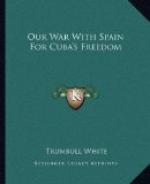The American army slept Thursday night within sight of its battlefield of the morrow. At daylight Friday morning the forward movement began. Hard fighting was expected at El Caney, guarding the northeastern approach to Santiago, and against this position were massed the commands of Generals Lawton and Wheeler, supported by Capron’s battery of light artillery. Both General Wheeler and General Young were sick, so General Sumner was assigned to the command of the former and Colonel Wood of the Rough Riders was placed in command of General Young’s cavalry brigade. Colonel Carroll of the Sixth cavalry took General Sumner’s place at the head of the First brigade of cavalry. Under General Lawton were three brigades—Colonel Van Horn’s, consisting of the Eighth and Twenty-second infantry and the Second Massachusetts volunteers; Colonel Miles’, consisting of the First, Fourth and Twenty-fifth infantry, and General Chaffee’s, consisting of the Seventh, Twelfth and Seventeenth infantry. On the eve of battle Colonel Van Horn was replaced by General Ludlow. Under General Sumner were four troops of the Second cavalry and eight troops of the First volunteer cavalry; under Colonel Wood the Rough Riders, the Tenth cavalry and four troops of the First cavalry. These two cavalry commands occupied the left of the San Juan plain for the attack on the blockhouse at that point. They were supported by Colonel Carroll’s brigade, consisting of the Third, Sixth and Ninth cavalry, and by Captain Grimes’ battery of the Second artillery.
The southeastern approaches to the city were commanded by General Kent’s division. His First brigade was commanded by General Hawkins and consisted of the Sixth and Sixteenth regular infantry and the Seventy-first New York volunteers. Colonel Pearson commanded the Second brigade, composed of the Second, Tenth and Twenty-first regular infantry, while the Third brigade, commanded by Colonel Worth, consisted of the Ninth, Thirteenth and Twenty-fourth regular infantry. Aguadores was their objective point. Grimes’ battery of artillery and the Rough Riders were to support General Kent in his attack on Aguadores, while General Duffield, with the Thirty-third and a battalion of the Thirty-fourth Michigan volunteers, was in advance of Kent’s left.
Captain Capron opens the fight.
The first shot of the engagement came at 6:45 o’clock Friday morning. It was fired by Captain Allyn M. Capron’s Battery E of the First artillery. The privilege of opening the engagement was granted this officer because of the killing of his son among the Rough Riders who fell near Sevilla. The Spanish answered the challenge from their forts and trenches about Caney, and immediately the battle was on. The Spaniards for a time fought desperately to prevent the town from falling into the hands of our forces, but before the fighting had been long under way the Americans and Cubans under Garcia gained advanced ground. Foot by foot the enemy was driven back into the village. The enthusiasm of the American forces was intense and their spirit quickly spread to the Cuban troops.




